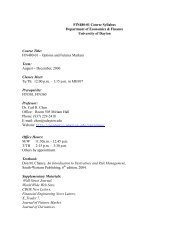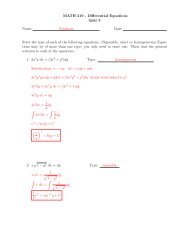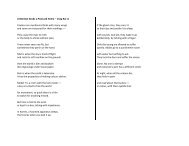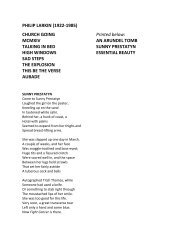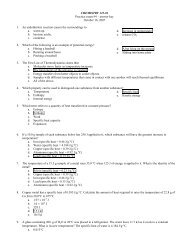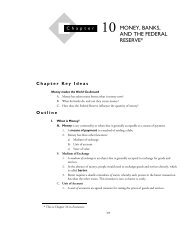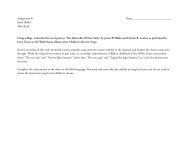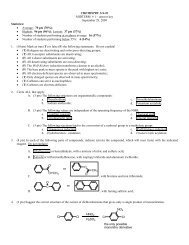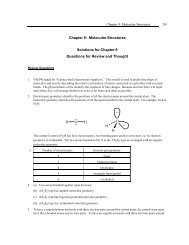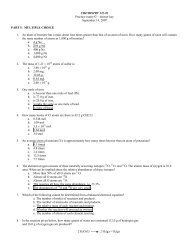Physics 206 Example Problems Newton's Laws of Motion
Physics 206 Example Problems Newton's Laws of Motion
Physics 206 Example Problems Newton's Laws of Motion
You also want an ePaper? Increase the reach of your titles
YUMPU automatically turns print PDFs into web optimized ePapers that Google loves.
Solution :<br />
There is a range <strong>of</strong> masses because static friction provides, up to its maximum value, the force it needs to<br />
maintain equilibrium.<br />
Maximum m1 : The maximum value <strong>of</strong> m1 is obtained by letting static friction take on its maximum<br />
value and act down the incline. For m1 I’ll use a coordinate system such that up is +y. For m2<br />
I’ll let + x be parallel to and down the incline and +y be in the direction <strong>of</strong> the outward<br />
normal to the incline. The free body diagrams for the masses look like:<br />
In the chosen coordinate systems:<br />
Fron1<br />
m1<br />
FG1<br />
Fron1<br />
= Tyˆ FG1<br />
= − m1 gE yˆ<br />
Fron2 = − Txˆ FG2<br />
= m2 gE sinθ xˆ − m2 gE cosθ yˆ N = Nyˆ FS<br />
= µS Nxˆ<br />
Newton’ s second law applied in the y-direction on mass 1 gives,<br />
Fron2<br />
m2<br />
θ<br />
FG2<br />
T − m1 gE = m1 a1 y = 0 ⇒ T = m1 gE<br />
Newton’ s second law applied in the y-direction on block 2 gives,<br />
Newton’ s second law applied in the x-direction on mass 2 gives,<br />
Using the results <strong>of</strong> Equations 1 and 2 in Equation 3 gives,<br />
Solving for m1 gives,<br />
N<br />
FS<br />
y<br />
x<br />
N − m2 gE cosθ = 0 ⇒ N = m2 gE cosθ ( 2)<br />
µS N + m2 gE sinθ − T = 0 ( 3)<br />
µS m2 gE cosθ + m2 gE sinθ − m1 gE = 0<br />
m1 = µs m2 cosθ + m2 sinθ = { ( 0. 4) ( 1 0) cos( 30 ◦ ) + ( 1 0) sin( 30 ◦ ) } kg ( 4)<br />
m1 , m ax = 8. 46 kg<br />
Minimum m1 : The minimum value <strong>of</strong> m1 is obtained by setting the static frictional force to its max-<br />
imum value but letting it act up the incline so that F<br />
S = − µS Nxˆ . The development leading to Equation<br />
4 still holds except that a negative sign precedes the term involving µS. That is,<br />
m1 = − µs m2 cosθ + m2 sinθ = { − ( 0. 4) ( 1 0) cos( 30 ◦ ) + ( 1 0) sin( 30 ◦ ) } kg ( 5)<br />
m1 , m ax = 1 . 54 kg<br />
The hanging block may have any mass between 1 . 54 kg and 8. 64 kg and the system will be in static equilibrium.<br />
B) Equation ( 1 ) gives the range <strong>of</strong> tensions as 1 5N to 83N.<br />
Problem 8. The coefficient <strong>of</strong> static friction between a box <strong>of</strong> mass 1 0 kg and a truck bed is 0. 4. What<br />
is the maximum possible acceleration <strong>of</strong> the truck for which the box does not slide on the truck bed?<br />
5<br />
( 1 )




